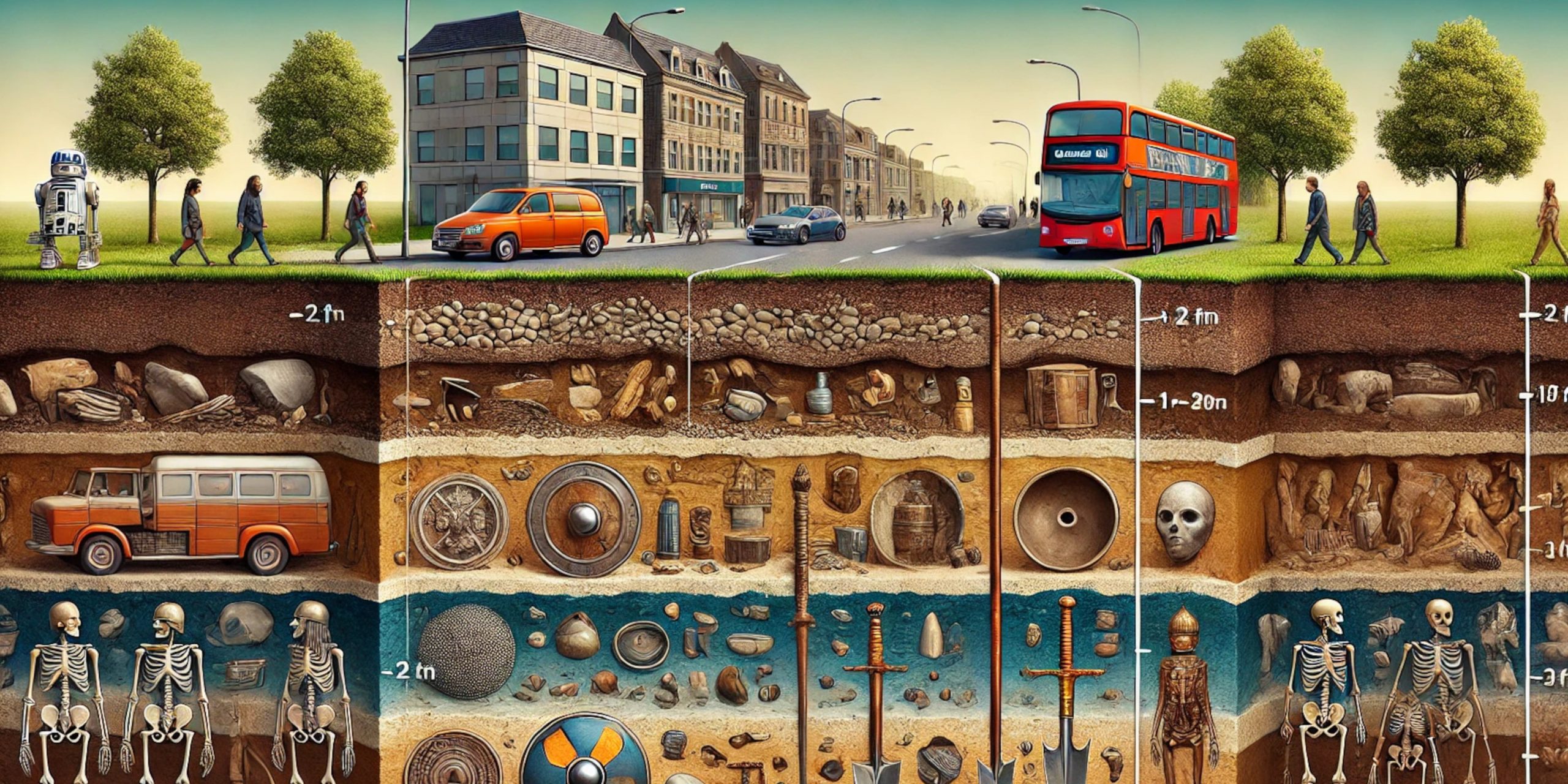
Archaeological remains are buried at varying depths depending on factors such as a site’s age, environmental conditions, and human activity. While some artefacts rest just beneath the surface, others lie buried under metres of sediment due to natural processes like erosion, flooding, or deliberate deposition. This variability is particularly relevant when searching for metal weapons and swords, which have been discovered at depths ranging from mere centimetres to several metres across different historical periods. Modern metal detectors and advanced technologies such as ground-penetrating radar (GPR) can aid in locating these objects, but their effectiveness depends on soil composition, burial depth, and the artefact’s size.
Factors Affecting Burial Depth
The depth at which artefacts are found is influenced by:
- Time Period: Older remains are generally deeper due to centuries of soil accumulation. For example, Bronze Age swords (c. 1600 BCE) are often buried deeper than medieval weapons (c. 14th century CE).
- Environment:
- Wetlands: Waterlogged soils can preserve metals but may require excavation through layers of peat or silt.
- Deserts: Arid conditions may leave artefacts near the surface due to limited soil formation.
- Urban Sites: Construction and landfill activities often bury historical layers under modern debris.
- Human Activity: Agricultural ploughing, looting, or deliberate burial (e.g., ritual offerings) can redistribute artefacts vertically.
Case Studies: Notable Sites with Metal Weapons
The table below highlights six key archaeological sites where swords and metal weapons were recovered, illustrating how burial depth varies by era and context.
| Period | Site | Location | Depth | Key Finds | Significance |
|---|---|---|---|---|---|
| Bronze Age (1600–1200 BCE) | Nebra Sky Disk Site | Germany | 1 metre (3 feet) | 2 bronze swords, Nebra Sky Disk, arm rings | Demonstrates early metallurgy and ritual deposition; discovered in 1999 by illegal treasure hunters. |
| Iron Age (500 BCE) | Hjortspring Bog | Denmark | 0.5–2 metres (2–6 feet) | 100+ iron swords, spears, war canoe | Evidence of mass weapon offerings after tribal conflicts; preserved in a peat bog. |
| Roman Era (1st–4th c. CE) | Vindolanda Fort | UK | 0.5–4 metres (2–12 feet) | Iron swords, daggers, armour | Wet clay soil preserved organic materials alongside military equipment. |
| Migration Period (5th–7th c. CE) | Sutton Hoo | UK | 2 metres (6 feet) | Pattern-welded sword, helmet, gold fittings | Elite Anglo-Saxon burial linked to King Rædwald; excavated in 1939. |
| Viking Age (9th–10th c. CE) | Gjermundbu Farm | Norway | 1 metre (3 feet) | Viking sword, chainmail, spearheads, helmet | Only complete Viking helmet ever found; grave of a high-status warrior. |
| Medieval Period (13th–14th c. CE) | Lake Trasimeno Battlefield | Italy | Shallow sediment | Swords, arrowheads, armour | Relics from the 1260 Battle of Trasimeno; found in lakebed silt. |
Metal Detector Depth Ranges
The effectiveness of metal detectors varies based on technology, soil type, and artefact size. Below is a comparison of common tools:
| Detector Type | Depth Range | Typical Finds | Considerations |
|---|---|---|---|
| Basic Detectors | 15–30 cm (6–12 inches) | Coins, jewellery, small relics | Struggles in mineralised or highly conductive soils. |
| Mid-Range Detectors | 0.6–1 metre (2–3 feet) | Swords, helmets, larger metal objects | Better in neutral soils; less effective in wet clay. |
| Advanced Deep-Seeking Models | 2–3 metres (6–10 feet) | Buried caches, large weaponry | Requires slow, methodical scanning; costly. |
| Ground-Penetrating Radar | Up to 15 metres (structural) | Subsurface structures, mass deposits | Maps soil layers but cannot distinguish metal types. |
Preservation and Soil Composition
Metal artefacts’ survival depends heavily on environmental conditions:
- Iron: Corrodes quickly in oxygen-rich soils but preserves well in waterlogged or anaerobic environments (e.g., Vindolanda’s wet clay).
- Bronze: More resilient; often found in stable conditions, though prone to patina formation.
- Gold: Resists corrosion entirely, making it detectable even after millennia.
Legal Considerations for Metal Detecting in the UK

In the UK, metal detecting is a popular hobby but is strictly regulated to protect archaeological heritage. Key laws and guidelines include:
- The Treasure Act 1996:
- Defines treasure as objects containing at least 10% precious metal (gold or silver) and over 300 years old, or groups of coins from the same find.
- Requires finders to report potential treasure to the local coroner within 14 days. Failure to do so can result in fines or imprisonment.
- Rewards are typically paid to both the finder and landowner if a museum acquires the treasure.
- Portable Antiquities Scheme (PAS):
- Encourages voluntary reporting of non-treasure finds (e.g., iron weapons, tools) to local Finds Liaison Officers (FLOs).
- Helps archaeologists map historical activity and preserves context for future study.
- Landowner Permission:
- Detecting without written permission on private land is illegal and classified as trespassing.
- Protected Sites:
- Metal detecting is banned on scheduled monuments (legally protected archaeological sites) without consent from Historic England or equivalent bodies.
UK Metal Detecting Laws at a Glance
| Regulation | Key Requirement | Penalty for Non-Compliance |
|---|---|---|
| Treasure Act 1996 | Report treasure finds within 14 days. | Unlimited fines, up to 3 months imprisonment. |
| Ancient Monuments Act 1979 | No detecting on scheduled monuments without consent. | Fines up to £50,000 or 6 months imprisonment. |
| Countryside Code | Obtain landowner permission; fill holes; avoid disturbing wildlife. | Trespassing charges or civil liability for damage. |
| PAS Guidelines | Report non-treasure finds voluntarily to aid research. | No penalty, but ethical obligation to preserve history. |
Conclusion
The burial depth of archaeological remains, particularly metal weapons like swords, reflects a complex interplay of time, environment, and human intervention. While Bronze Age relics may lie 1 metre deep, medieval battlefield debris could linger near the surface under silt or water. Modern technologies like deep-seeking metal detectors and GPR enhance discovery chances, but soil chemistry and artefact size remain critical factors.
In the UK, responsible metal detecting is governed by the Treasure Act 1996 and ethical guidelines. These laws ensure that historically significant finds are preserved for public benefit, while unauthorised or careless detecting risks damaging irreplaceable context. By adhering to regulations and collaborating with archaeologists, detectorists play a vital role in unearthing and protecting our shared heritage.
Note: Always consult the Portable Antiquities Scheme (PAS) and Historic England for up-to-date guidance before detecting.



